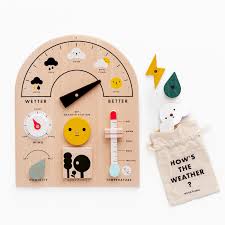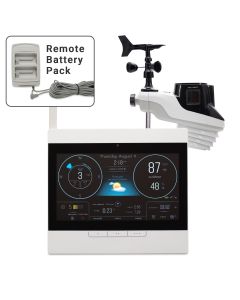A weather station for kids and elders is a great educational tool for all to observe and track weather station data. By using simple materials or advanced devices like the AcuRite weather station and Tempest weather station. In this guide, we’ll dive into fun DIY weather station projects for kids and explore how to engage them in learning about weather patterns, whether at home or in school.
1. What is a Weather Station for Kids?
A weather station for kids is a set of tools or instruments designed to measure and track weather conditions like temperature, humidity, wind speed, and rainfall. These stations can be built using everyday household items or pre-made systems like the AcuRite weather station or Ambient weather station, making it easy for children to observe changes in the atmosphere. Whether used for a school project or a fun activity at home, creating a weather station helps children understand the science behind meteorology.
Why Build a Weather Station For Kids?
Building a weather station for kids is an exciting way to teach children about the weather, nature, and science. By observing weather patterns, kids develop an understanding of meteorology and climate. Plus, they can engage in fun hands-on activities that foster learning through experimentation

2. Building a DIY Weather Station for Kids at Home:
Creating a DIY weather station for kids is an exciting recycling project that teaches them how to observe and record the weather while using everyday materials. Below are the essential weather instruments you can build with your children:

1. Rain Gauge (Measuring Precipitation)
You can create a simple rain gauge using a clear plastic bottle. Mark the side with measurements to track the amount of rainfall. This project teaches children how to measure precipitation and understand its impact on the environment.
2. Thermometer (Measuring Temperature)
Place a thermometer in a shaded area to get accurate readings without direct sunlight interference. This helps children learn how to track temperature changes daily and over time.
3. Wind Vane (Measuring Wind Direction)
Craft a wind vane out of cardboard and a straw to show the wind direction. It’s an easy project that demonstrates how wind patterns affect weather systems.
4. Barometer (Measuring Atmospheric Pressure)
Use a jar and a balloon to build a simple barometer. As the air pressure changes, the balloon moves, giving kids an easy way to track atmospheric pressure.
3. Using Home Weather Stations Like AcuRite & Tempest
For more accurate and detailed readings, you can introduce your child to home weather stations like the AcuRite weather station or the Tempest weather station. These devices are designed for easy setup and automatic data collection, tracking everything from humidity to wind speed. Kids can compare the data from their DIY weather station with these professional-grade tools.

AcuRite Weather Station
The AcuRite weather station is known for its easy-to-use features, making it perfect for home use. It monitors temperature, humidity, and even rainfall, providing children with comprehensive weather data.
Tempest Weather Station
The Tempest weather station offers high-tech features like lightning detection and solar power. It’s a great tool for teaching children about advanced meteorology and real-time data collection.
4. Weather Station Data: Understanding Atmospheric Changes
Collecting weather station data helps children recognize patterns in weather conditions. This data includes temperature, humidity, rainfall, and wind direction, all of which can be tracked over time. By analyzing this information, kids will learn how to make predictions about future weather conditions, much like professional meteorologists.
5. Weather Stations for School Projects: Engaging Kids in Science
For a school project, creating a weather station is a hands-on way for children to explore weather phenomena. Teachers can guide students in a classroom by building basic weather instruments, such as a rain gauge, thermometer, or wind vane. These activities can also double as an art project, allowing students to decorate and personalize their instruments while fostering critical thinking and problem-solving skills.

How to Make a Weather Station for School
- Rain Gauge: Use a clear bottle and ruler for measuring rainfall.
- Wind Vane: Craft a vane using paper and a straw to detect wind direction.
- Thermometer: Track temperature changes daily for a full week. These DIY weather instruments are fun, easy to build, and great for learning about natural weather processes.
6. Remote Automated Weather Stations (RAWS) for Data Tracking:
For those interested in automated systems, remote automated weather stations (RAWS) like the Cycloneport weather station or the Orion weather station are used in more professional setups. These stations collect weather data in real-time and are often used in remote areas to monitor atmospheric conditions.
Cycloneport Weather Station:
This advanced station tracks severe weather patterns like storms and cyclones. Children can study the differences between severe weather and daily changes by comparing data.
Orion Weather Station:
Known for its reliability, the Orion weather station is used for both educational purposes and professional weather tracking. Schools can use this station to teach students about high-precision weather data collection.
7. Educational Benefits of Weather Stations for Kids:
Building a weather station for kids is more than just a fun activity. It’s an educational experience that introduces children to the science of meteorology and environmental studies.
- Hands-on Learning: Kids engage in interactive learning by observing weather changes in real-time, fostering curiosity and scientific thinking.
- Understanding Weather Patterns: Using weather stations helps children learn about temperature, humidity, wind speed, and atmospheric pressure, connecting theory with practical knowledge.
- STEM Skills Development: Weather stations enhance kids’ skills in science, technology, engineering, and math (STEM) through data collection, analysis, and interpretation.
- Environmental Awareness: Children gain a deeper understanding of environmental changes, climate, and sustainability by observing natural weather phenomena.
- Critical Thinking & Problem-Solving: Tracking weather patterns encourages kids to ask questions, form hypotheses, and solve problems based on their observations.
- Data Literacy: Kids learn how to read, interpret, and make conclusions from data, a vital skill in today’s technology-driven world.
- Encourages Outdoor Activities: Using weather stations inspires children to explore the outdoors, making them more engaged with nature and the environment.
- Boosts Collaboration: Weather-related projects promote teamwork, especially in school settings where children can work together to monitor and analyze weather data.
Conclusion:
A weather station is an amazing tool for kids to explore the environment around them. Whether building a DIY weather station for school or using a professional home weather station like the AcuRite or Tempest, children will gain valuable knowledge about weather patterns and science. Encourage your child to become a mini meteorologist today with these fun, engaging projects!
FAQS:
What is a weather station for kids?
A weather station for kids is a simple educational tool that helps children learn about weather patterns by measuring elements like temperature, wind speed, humidity, and rainfall using easy-to-read instruments.
How to make Weather Instruments (Anemometer)?
To make a simple anemometer, use plastic cups and straws. Attach 4 cups to the ends of a cross formed by the straws, and place it on a pencil with an eraser. This will allow it to spin in the wind, measuring wind speed.
How to build a simple weather station?
A simple weather station can be built by combining homemade instruments like a thermometer (for temperature), anemometer (for wind speed), rain gauge (for rainfall), and a barometer (for air pressure), using everyday materials.
How to build weather instruments for kids?
Kids can build weather instruments using household items like plastic cups, straws, and bottles. For example, a rain gauge can be made from a plastic bottle to measure rainfall, and a wind vane can be crafted using paper and straws to show wind direction.
What is the purpose of a weather station?
The purpose of a weather station is to monitor and collect data about the weather, such as temperature, wind speed, humidity, and precipitation, helping predict weather patterns and providing information for weather forecasting.
What is a weather observation system?
A weather observation system refers to the tools and methods used to observe and measure atmospheric conditions, like temperature, wind, and humidity, to gather data for weather forecasting and climate monitoring.
External Resources:
Website: National Weather Service
Website: NASA Climate Kids

Empowering parents to raise happy, confident kids. Get practical parenting tips and advice on our blog, Smart Parent Guides.
